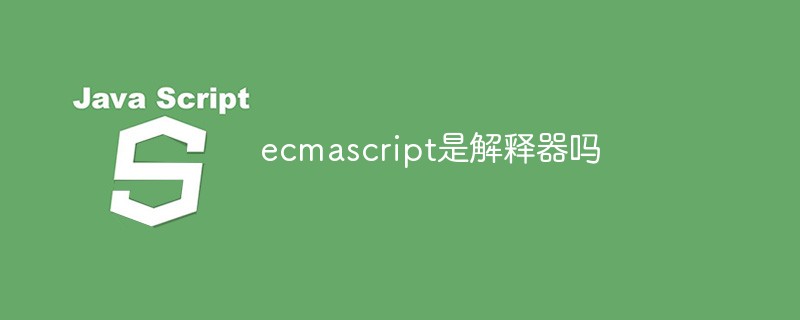
ecmascript is the interpreter. ecmascript is a script programming language standardized by Ecma International through ECMA-262. It is an interpreter and is responsible for translation. It is the core part of the js language and describes the syntax and basic objects of the js language.

The operating environment of this tutorial: Windows 7 system, ECMAScript version 6, Dell G3 computer.
A complete JavaScript implementation consists of the following 3 different parts:
Core (ECMAScript): The core part of the language, which describes the language syntax and basic objects.
Document Object Model (DOM): Web page document operation standard, describing methods and interfaces for processing web page content.
Browser Object Model (BOM): The basis for client and browser window operations, describing the methods and interfaces for interacting with the browser.
ECMAScript (es): Responsible for translation, the core interpreter of js.
ECMAScript defined by ECMA-262 is an internationally recognized standard scripting language specification that has no dependency on web browsers. The ECMA-262 standard mainly stipulates that the language consists of the following components:
Syntax
Variables and data types
Keywords and reserved words
Operators
Control statements
Object
ECMAScript version 5.0 was officially released in 2009. For a long time, JavaScript was used in accordance with the 5.0 standard. In 2015, ECMAScript 6 was released as an official version, officially called ECMAScript 2015. ECMAScript defines all properties, methods and objects of the scripting language. Therefore, you must follow the ECMAScript standard when coding web client scripts.
5 basic data types: Undefined, Null, Boolean, Number, String, Symbol (new in es6)
1 3 complex types: object
5 reference types: Array, Object, Function, Date, RegExp
3 basic packaging types: Boolean, Number, String
2 Single built-in object: Global, Math
1. Four ways to determine data type
typeof
const a = ""
console.log(typeof(a)) => String
const b = 1
console.log(typeof(b)) => Number
const c
console.log(typeof(c)) =>Undefined
const d = []
console.log(typeof(d)) => Object
const e = {}
console.log(typeof(e)) =>Object
const f = null
console.log(typeof(f)) =>Object //null 作为尚未创建的对象instanceof
This method is only suitable for determining the object type
const arr = [] console.log(arr instanceof Array)=> true console.log(null instanceof Object) ---> false console.log([function] instanceof Object | Function) --> true
Object.prototype.toString.call()
This method can detect all data types and is recommended. Because toString is the prototype method of Object, and Array Function, etc. are all instances of Object. All have overridden the toString method. What is returned is a string of type
Object.prototype.toString.call(null) => [object Null]
Object.prototype.toString.call(Math) => [object Math]
Object.prototype.toString.call(function(){}) => [object Function]
Objdec.prototype.toString.call(new Date) => [object Date]
Object.prototype.toString.call(Symbol()) => [object Symbol]
Object.prototupe.toString.call(undefined) => [object Undefined]
Object.prototype.toString.call(123) => [object Number]
Object.prototype.toString.call(true) => [object Boolean]
Object.prototype.toString.call('123') => [object String]
Object.prototype.toString.call({}) => [object Object]
Object.prototype.toString.call([]) => [object Array]constructor
Determine the constructor of the object.
1. null is the starting point of the js prototype chain, there is no constructor
2. undefined has no constructor
3. [].constructor === Array --- > true
【Related recommendations: javascript learning tutorial】
The above is the detailed content of Is ecmascript an interpreter?. For more information, please follow other related articles on the PHP Chinese website!